Now & New
- Eat
Seasonal Cuisine Nakashima: A Bargain Michelin Three-Starred Restaurant
When traveling internationally, tourists can choose a destination for a plethora of reasons: history, nature, shopping, food, pop culture, wildlife, the list goes on. It’s no understatement that those who come to Japan on vacation may have a desire to gorge on Japanese food every chance they get, but with only so much time in the country, how do tourists determine the best restaurants worth their time, money, and energy spent getting there? For those with higher dining budgets, the Michelin Guide may serve as a reliable reference, but most of the entries for Japan tend to be in the Greater Tokyo and Kansai metropolitan areas. That said, Hiroshima does have a few restaurants that have been awarded Michelin stars, but only one establishment, Seasonal Cuisine Nakashima (季節料理なかしま), has ever been granted the most prestigious three-star rating.
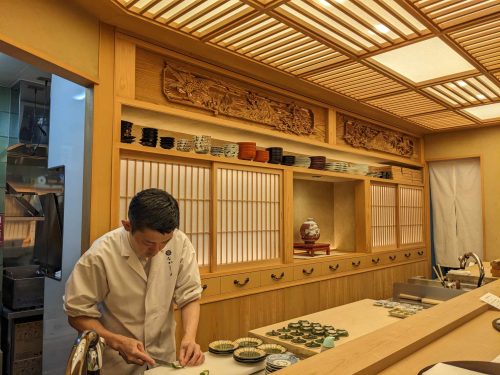
It also doesn’t hurt that Nakashima is one of the cheapest three-star restaurants in the world, so those in the know of gourmet Japanese food will go out of their way to dine here when in Hiroshima. Reservations are necessary and made on the restaurant’s website, which requires prospective diners to register their credit cards to pay beforehand. That way, customers only need to show up on the night of their meal and can leave without a care in the world after finishing their food. In spite of its humble exterior, diners will be flabbergasted by the grandiose restaurant interior when being seated, as intricate wood carvings can be seen on the upper wall behind the counter, and all the lacquerware dishes to be used in serving the dishes of the course meal are stacked in an orderly fashion on top of the shelf.
For Starters
I was seated at the leftmost counter seat that night, as the counter was almost completely occupied by diners, most of whom were non-Japanese like myself. The table was set with a platform on which the course plates and bowls would be placed, a pair of chopsticks bound with paper and resting on a chopstick rest, a cloth napkin nicely folded up, the bill of fare in English (Japanese speakers who don’t read English would simply listen to oral explanations from the staff), a moist towelette holder, and a fancy paper coaster for drinks. Speaking of drinks, it must have been somebody’s birthday or anniversary as a special welcome drink was brought out for every single customer before the start of the meal. Shortly after, the head chef came out to greet his guests one by one, and gave a disclaimer to his international customers that he doesn’t speak English (though I thought his ability was sufficient enough for serving dinner).
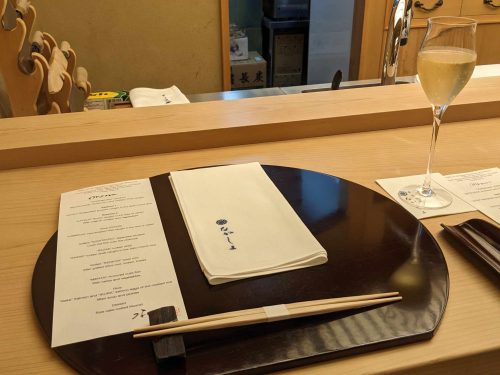
The first item to be brought out was a dobinmushi (土瓶蒸し), which describes food steamed in an earthenware pot. Servers bringing out the food gave an explanation on the dish’s contents, how to eat it, and other trivia such as the history and geography behind the container. English ability varied by server, but when those dining with me couldn’t understand the English explanation (or lack a bit of information that was present only in the Japanese explanation) I was able to help with interpretation.
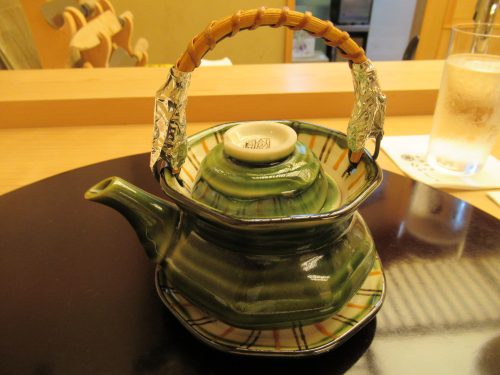
This dobinmushi doubled as food and drink: first, the diner removes the cup resting on the lid of the pot, and pours the dashi (stock soup) from the pot into the cup. A piece of sudachi (a green, Japanese citrus fruit) can be squeezed so its juice can accentuate the flavor of the dashi. At any point while drinking or after finishing the dashi, the diner may also lift the lid and eat the matsutake mushrooms and pike conger that had been steamed inside the pot.
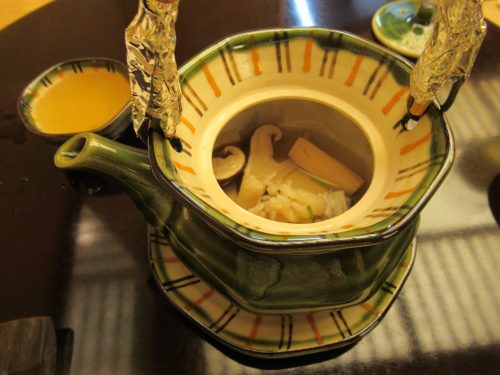
Initial Fish Dishes
Up next were two plates of sashimi, the first of which was described by the menu as “red-spotted grouper,” but when I tried looking up that species later, nothing came up. After entering the Japanese name 赤魚鯛 (あこうだい), I got the scientific name Sebastes matsubarae, as well as the English name “rose fish,” which I had heard for the first time. This sashimi was fished from the Seto Inland Sea, and came garnished with fresh wasabi, soy sauce, salt, and sudachi so we could indulge in a spectrum of flavors with the same fish flesh. The sashimi also came in two different colors and textures, one type being firmer than the other, so no two bites were ever the same, but all were scrumptious.
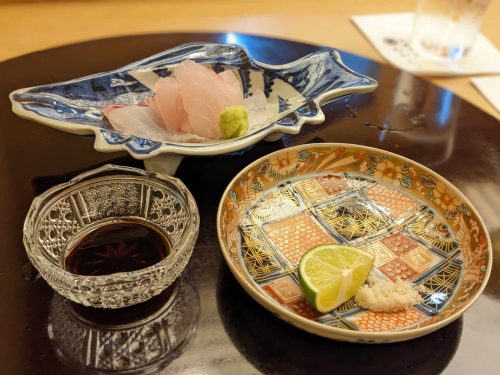
The second sashimi dish was of a bonito caught in the faraway Sea of Japan, marinated in vinegar, and covered in veggies. I had to do a double-take when this plate arrived to make sure there was actually fish underneath the onions. Seeing as having sashimi as one’s meal tends to see few vegetables, a recipe like this is a clever idea for slipping some much-needed nutrients and more variety in flavor.
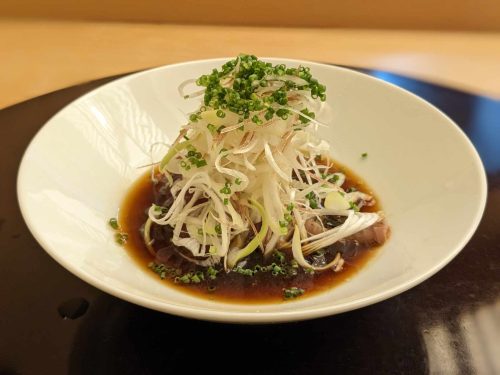
After those was a dashi featuring a species of fish called the “splendid alfonsino,” but more commonly referred to in sushi restaurants as red snapper, golden eye snapper, or kinmedai (金目鯛). This fish was also harvested from the Sea of Japan, and served alongside some mushrooms and a green block of fu (wheat gluten), and topped with some exotic leaves. Of more particular note than the dashi was the bowl in which it was served.
Moment of Joy: Eating History
Have you ever toured a museum inside a Japanese castle and seen the dishware used by the feudal lords at the time? This red lacquerware bowl was just like that; our server explained the age of every pot, plate, and bowl, and they were all over a century old, dating back to the Taisho, Edo, and possibly other periods in Japanese history. As if simply being able to eat here wasn’t enough, knowing that I was eating out of historical relics added an extra layer of prestige to my dinner. While some folks eating out may opt for being able to watch sports on TV or a live show, in my humble opinion, education on what I am eating or eating with is a suitable alternative form of entertainment.
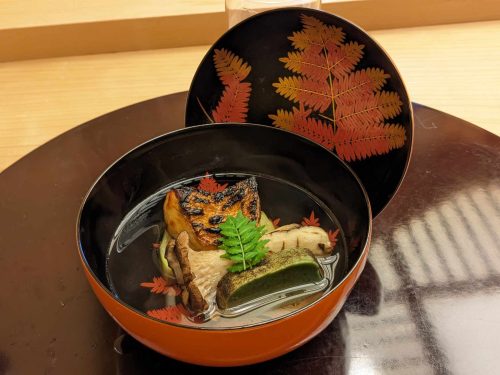
Seafood Spectacles
The piscine procession continued, with cooked seafood being the focus of subsequent dishes. The chef cut off some flesh from a rosy seabass, also known as nodoguro (喉黒 – のどぐろ), and started grilling it in the kitchen out of sight, and while that was happening, a server picked up the rest of the fish’s body and showed it to the diners, letting us know what we were about to sink out teeth into. Most of us were in awe at the size of the fish and its gaping red eyes, and when the mouth was moved, the fish resembled a puppet.
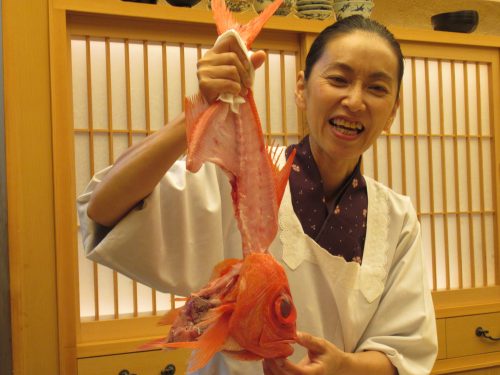
Eventually, the rosy seabass corpse was put away and the next fish dish was placed before our ravenous eyes. The fish was seared to perfection and paired with a fried potato-like vegetable that was drizzled with miso sauce. I squeezed the sudachi wedge onto the fish for a tangy kick before proceeding to savor every crispy bite of fish.
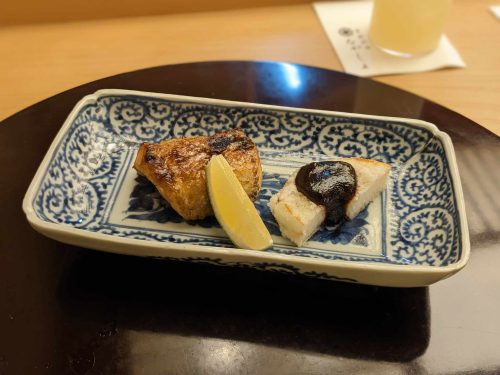
What came next was still seafood, but not a fish at all. It was a steamed turban shell—called sazae (栄螺) in Japanese—that was extracted from its shell before being cooked, chopped up into pieces, and put back into its shell with sauce and vegetables. The shell then rested atop a pile of salt (we were warned not to eat the salt) before the dish was served. Diners would have to use a tiny pick or fork to dig all the way into the turban shell and gobble up every last bite (drinking the sauce was optional).
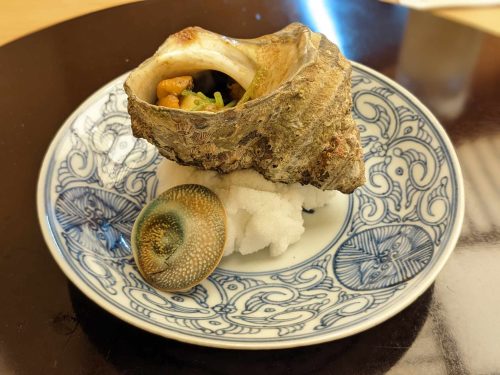
That was followed by a boiled lotus root dumpling, but it was more like a dumpling in the German sense rather than the East Asian sense. First, everyone’s bowls, each containing a lotus root dumpling topped with dried seaweed, were brought out onto the preparation counter for final assembly. Next, the chef took a ladle and poured a thick, brown sauce into every bowl. Then, the servers squeezed a bit of mustard onto the wet dumplings and covered the dish with lids before serving them.
Our server explained that the underside of the lid had a turtle design that symbolizes longevity, and was therefore an auspicious animal to put on ceramic wares. I thought that was a cool concept, so I engaged in a brief photoshoot of both lid and bowl before digging in. The essence of lotus root was bracing, but with the texture of bread rather than vegetable, and the sauce was delectable enough to warrant cleaning the bowl entirely to reveal the design at the bottom: a crane. The turtle and crane can often be seen together in works of art to jointly illustrate and wish for longevity, so I was half-expecting to see that when I finished my food.

After that, it was back to fish, with the next item being steamed armored cusk fish on a bed of fresh greens. Besides the onion-covered sashimi, this plate was the richest in veggies I had seen so far, but no problem with having a salad later in the meal. As with the dish before, the design on this plate underneath the food was something to look forward to, although it would be inappropriate to race through food of this caliber.
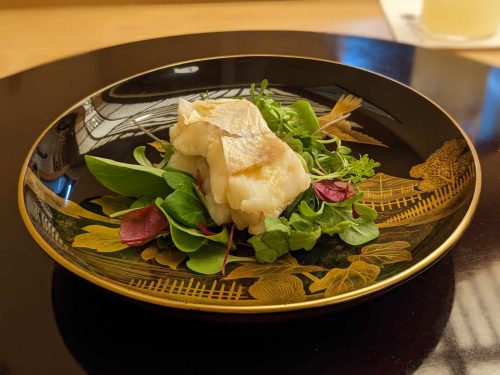
Hitting the Spot
At this point in the course, they brought out the rice, which during a kaiseki meal, signifies that the meal is about to end. However, rice at Nakashima is never just ordinary, steamed white rice, for the chef will always mix in other ingredients appropriate to the season to fit the mood. The servers even made a spectacle out of this one, as they initially brought out earthenware pots of rice and added salmon and leafy greens on top.
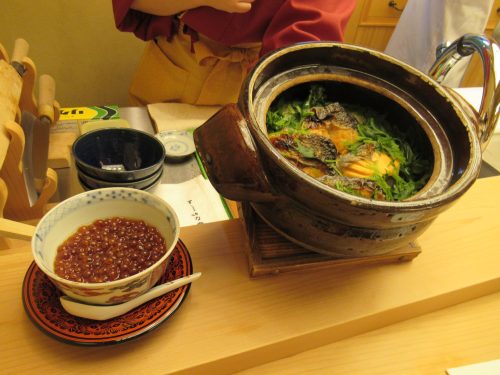
Autumn is the best time of year to enjoy salmon as well as their spawn, so the idea was to mix the fish, veggies, and rice together before topping the mixture with salmon roe. The quantity of the ingredients was enough to feed multiple people, so it took a fair amount of strength and time from the server to have everything uniformly jumbled together. Quite frankly, they could’ve had this taken care of in the kitchen, but I know I speak for more than myself when I say we were thankful for this form of entertainment.
The mixed rice was then scooped into individual rice bowls and served to the diners alongside a bowl of miso soup and a dish with assorted Japanese pickles, the classic Japanese meal spread. They let the customers sprinkle salmon eggs on top of the rice at will, and there were free refills on rice, salmon roe, miso soup, and pickles. All of the uneaten rice was packed up and evenly distributed to the customers to take home, but naturally, the restaurant kept the unused salmon spawn. I exploited Nakashima’s generosity and got refills on rice and salmon eggs until my belly reached its limit.
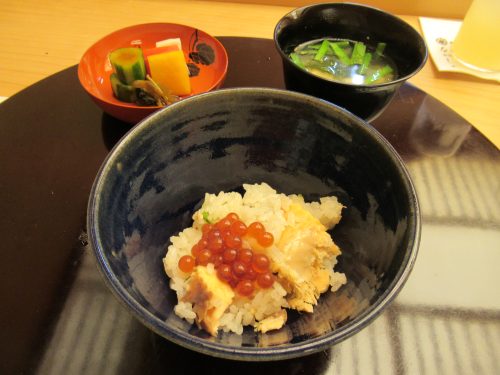
I didn’t worry too much about dessert with regard to my stomach volume, since desserts in restaurants like these are typically small. Additionally, there is the Japanese concept of betsubara (別腹 – “the other stomach”), which stipulates that because dessert is stored in a different compartment in the body (not biologically true, but I see the logic from a culinary standpoint), being full can never be used as an excuse to refuse dessert after the meal. True to its name, the dessert of the night involved a seasonal fruit: half of a muscat daifuku, which is a recipe that involves coating fruit in sweet bean jam (sometimes, but not this time) and a mochi skin dusted with rice flour. The dessert came with a miniature drawing of a window with a view of the full moon and the word shoshuu (初秋 – early autumn), which was when we visited the restaurant.
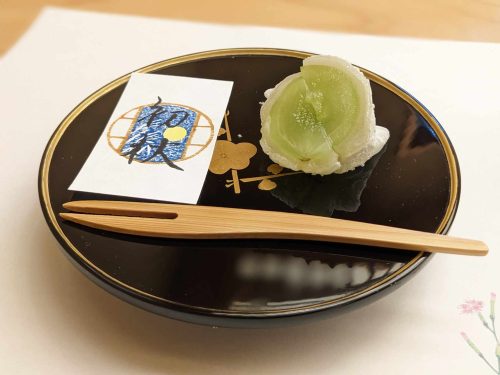
After we finished dessert, which came with tea, the restaurant staff gave each of us a commemorative postcard (remember that birthday/anniversary?) and offered to call a taxi for every party on its way out. It was also at this time that the chef made himself available for banter and group photos, and those dining with me jumped at that chance out of excitement. Dinner at Seasonal Cuisine Nakashima is indubitably one of the fanciest meals one can have in Hiroshima, and because diners are essentially eating the seasons at this restaurant, tourists both domestic and international have reason to drop by at least four times (at different points in the year, of course). I can see now why Nakashima piqued the interest of Michelin and earned its stars, as it would be remiss for any tourist who loves Japanese food to pass this place by. Here’s hoping Michelin keeps its eyes on the numerous other fancy joints in our peaceful city and elevates Hiroshima’s fame as a key gourmet destination in Japan, worthy of a detour down south in every season.
Written by the Joy in Hiroshima Team
